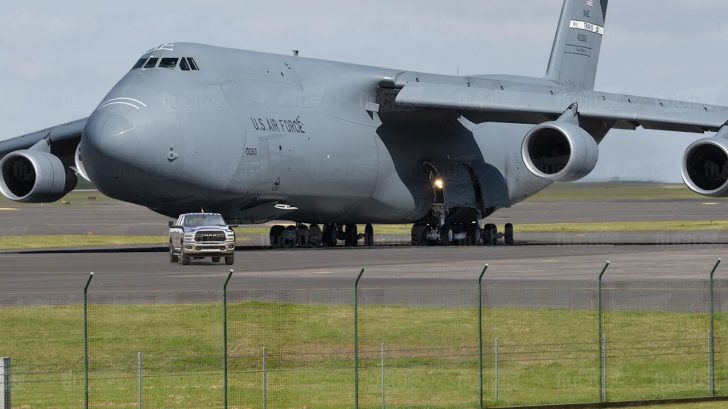1. Routine Checks
Like any other airplane, the C-5 gets its wheels checked first by the ground crew. Its 28 wheels can be individually raised for maintenance. In this step, the brakes of the C-5 are also tested. A well-maintained set of wheels is very important for a massive plane like the C-5.
2. Loading Up Vehicles
After checking the wheels, it’s time to load up any kind of cargo deemed necessary for its mission. Vehicles with wheels are taxied and parked on the rear ramp first while it is checked for any damages. When finished, the crew will guide the vehicle further inside for transport.
3. Mission Briefings
Before the flight takes place, the crew is briefed on their current mission. Sometimes, these briefings can be reiterated outside the aircraft with all the crew present. They go over the details of the mission before entering the C-5.
4. Takeoff and Landing
The C-5 will then prepare for takeoff after the pilots do their routine pre-flight checks. In landings, ground crew and guide cars will aid the C-5 as it gets taxied. Meanwhile, the crew will ready the C-5 for unloading.
5. Cleaning and Maintenance
As soon as its contents are unloaded, the C-5 is towed by a vehicle for another round of cleaning and maintenance. The Galaxy gets a well-deserved shower to clean off the accumulated dust and elements during its mission.
6. Loading Pallets
If pallets are required to be loaded, the crew can opt to use a specialized truck with a raisable platform and a conveyor belt system that can load the pallets automatically inside. If this is the case, the C-5’s rear ramp is only extended parallel to the fuselage since the truck can raise its platform.
7. Process of Kneeling
In some cases, the C-5 can “kneel”. Hydraulic lifts are used on the wheel bogies which enables the C-5 to kneel the nose down, the tail down, or evenly with the fuselage inches from the ground. This feature makes loading vehicles a lot easier compared to the C-17.
8. Scheduled Maintenance
A C-5 has an 8-year scheduled maintenance timeline. Once every 8 years, a PDM is performed to maximize its lifespan. This series of inspections go through pre-flight checks, home-station checks, Maintenance Steering Group-3, MSG-3 Major, and Programmed Depot Maintenance.
9. Thorough Iso Checks
2 years after the PDM, a Minor Isochronal inspection is done to keep the plane airworthy. According to Master Sgt. Harry Sinex, the 167th isochronal coordinator, there are more than 10,000 items needed to be checked while roughly 2,500 tasks are done during inspection. On average, it takes 39 days to complete the inspection.
10. Demonstration of Coordination
The act of loading and unloading the C-5 is a demonstration of the coordination required from everyone involved. Multiple pilots, engineers, crew chiefs, and loadmasters are needed to participate in every mission. Engineers control fuel balancing, pressurization, cooling, and many more. Crew Chiefs have constant contact with ground maintenance crews, and Loadmasters ensure the most efficient and safe manner of loading cargo into the C-5.



